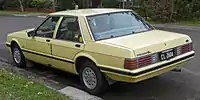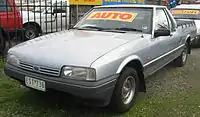Ford Falcon (XF)
The Ford Falcon (XF) is a full-sized car that was produced by Ford Australia from 1984 to 1988. It was the third and final iteration of the fourth generation of the Falcon and also included the Ford Fairmont (XF)—the luxury-oriented version. Between 1993 and 1999, this series provided the platform for the Falcon utility (XG and XH) that was sold alongside the fifth-generation Ford Falcon sedans and wagons.
| Ford XF Falcon | |
|---|---|
_sedan_(2015-07-09)_02.jpg.webp) Ford Fairmont sedan | |
| Overview | |
| Manufacturer | Ford Australia |
| Also called | Nissan XFN (utility 1988-1991) |
| Production | October 1984 – February 1988 (sedan, wagon) October 1984 – March 1993 (utility, panel van) |
| Body and chassis | |
| Class | Full-size |
| Body style | 2-door coupé utility 2-door panel van 4-door sedan 5-door station wagon |
| Related | Ford ZL Fairlane Ford FE LTD |
| Powertrain | |
| Engine | 3.3 L I6 4.1 L I6 (Carburetor) 4.1 L I6 (EFI) |
| Transmission | 3-speed automatic (column, floor) 3-speed Borg Warner 0501 manual (column) 4-speed Borg Warner 0503 manual (floor) 4-speed Borg Warner 0506 manual (floor) 5-speed Borg Warner 0507 manual (floor) |
| Dimensions | |
| Length | 4,775 mm (188.0 in) |
| Width | 1,860 mm (73.2 in) |
| Height | 1,367 mm (53.8 in) |
| Curb weight | 1,333 kg (2,939 lb) |
| Chronology | |
| Predecessor | XE Falcon |
| Successor | EA Falcon (sedan, wagon) XG Falcon (utility, panel van) |
Overview
The XF sedan and wagon range was sold between October 1984 and February 1988,[1] with the utility and panel vans running through to March 1993.
The ride and handling were described as competent, but the unpowered steering was heavy at low speeds with an overly strong castor action after performing a manoeuvre such as a U-turn. Power steering was an option on higher-specification models, which in contrast was described by some as too light. Engines were modified to run on unleaded fuel from January 1986. The XF series remains Ford's best-selling Falcon model ever built by Ford Australia, with 278,101 built, helped by a prolonged run of the utility and panel van models.[2]
Powertrains
XF models were available with a choice of 3.3 or 4.1-litre engine six-cylinder engines.[3] The 4.1-litre unit was standard on Fairmont models and the S-Pack.[4]
Transmissions available were 3 speed column shift, four- or five-speed manual floor shift, or the much more popular three-speed automatic with the selector lever located either on the floor or the column in cars that seat six. In three-seat utilities and vans, the three-speed manual on the column was standard.
Specification levels
- Falcon (utility and panel van)
- Falcon GL (utility, panel van, sedan, and wagon)
- Falcon GLS Ute (utility) [5]
- Fairmont (sedan and wagon)
- Fairmont Ghia (sedan and wagon): the luxury Ghia featured a 4.1-litre fuel-injected or carburettor inline six-cylinder engine, and a trip computer that calculated fuel consumption and driving times, among other things. The drive line consisted of a BW40 three-speed auto with either a 2.77 or 2.92 LSD and four-wheel disc brakes. A wagon variant of the Ghia was made available from October 1986.[6]
An optional "S" pack was available on some models, featuring body stripes, fog lamps, styled wheels, Falcon "S" badging, steering rack adjustment, driver's lumbar support, driver's seat tilt and footrest, and sports instrument cluster.[3]
Ford produced some limited-edition, value-packaged vehicles during the XF series, including the Falcon Silver Edition sedan of 1985 to commemorate the 25th anniversary of the Ford Falcon in Australia. Also, a six-seater GL-based Falcon Family Edition sedan and wagon were offered in 1986. These limited-edition vehicles featured unique versions of two-tone "style-tone" paintwork.
 1986–1988 Ford Falcon GL sedan
1986–1988 Ford Falcon GL sedan_GL_station_wagon_(2015-11-11)_02.jpg.webp) 1987 Ford Falcon GL wagon
1987 Ford Falcon GL wagon_Silver_Anniversary_sedan_(2015-07-03).jpg.webp) 1985 Ford Falcon Silver Anniversary sedan
1985 Ford Falcon Silver Anniversary sedan 1986–1988 Ford Fairmont Ghia sedan
1986–1988 Ford Fairmont Ghia sedan 1990–1993 Ford Falcon utility
1990–1993 Ford Falcon utility 1988–1990 Ford Falcon utility
1988–1990 Ford Falcon utility Ford Falcon Van (XF)
Ford Falcon Van (XF)
Nissan Ute
.jpg.webp)
| External image | |
|---|---|
The Nissan Ute was a badge-engineered version of the XF Falcon utility sold by Nissan in Australia from July 1988 to September 1992.[7] Nissan Utes were sold as a result of a model-sharing scheme known as the Button car plan. In an attempt to rationalise the Australian automotive industry, the Button plan induced car manufacturers to share core platforms. For this particular vehicle, XF series Ford utility vehicles were rebadged as "Nissan".
Nissan did not offer the various equipment levels of the Ford donor vehicle, instead offering only two basic trims (DX and ST) without the option of an "S" pack. The plan was generally considered a "disaster" by the industry, as the car buying public steered clear of the badge-engineered vehicles. Furthermore, spare parts could often be purchased from only the original vehicle maker—as was the case with the Nissan Ute. The model code was "XFN".
Motorsport
Due to the lack of a V8 engine, the XF Falcon was not suitable for involvement in the Australian Touring Car Championship, with most Ford supporting drivers and/or teams electing to race the Ford Mustang or Ford Sierra RS Cosworth under the new Group A regulations.
The XF Falcon, however, was raced in the AUSCAR series, with Jim Richards winning the first AUSCAR series in a XF Falcon. XF AUSCAR's were fitted with 5.8 L 351 Cleveland V8s (subsequent Falcon models in AUSCAR racing would use the 5.0 L 302 cid V8), and had an aero kit designed by Ford Australia designer Wayne Draper.[8]
References
- "Ford Falcon XF". Unique Cars and Parts. Retrieved 6 September 2009.
- "Falcon XF Technical Specifications". Unique Cars and Parts. Retrieved 6 September 2009.
- "XF Falcon (1984 - 1988)". Falcon Facts. Archived from the original on 26 August 2014. Retrieved 11 May 2010.
- Ford Fairmont and Fairmont Ghia sales brochure, Ford Australia, October 1984.
- New Ford Falcon Utes (flyer), Ford Australia, February 1988
- Davis (1987), p. 186.
- Kenwright, Joe (1 May 2005). "Day of the Clones PtII". CarPoint. Retrieved 26 July 2009.
- "Millenium Falcon". Archived from the original on 10 November 2013. Retrieved 10 November 2013.
Further reading
- Davis, Tony (1987). Aussie Cars. Hurstville, New South Wales: Marque Publishing. ISBN 978-0-947079-01-7.
